1993 CHEVROLET ASTRO PASSENGER check engine
[x] Cancel search: check enginePage 264 of 345
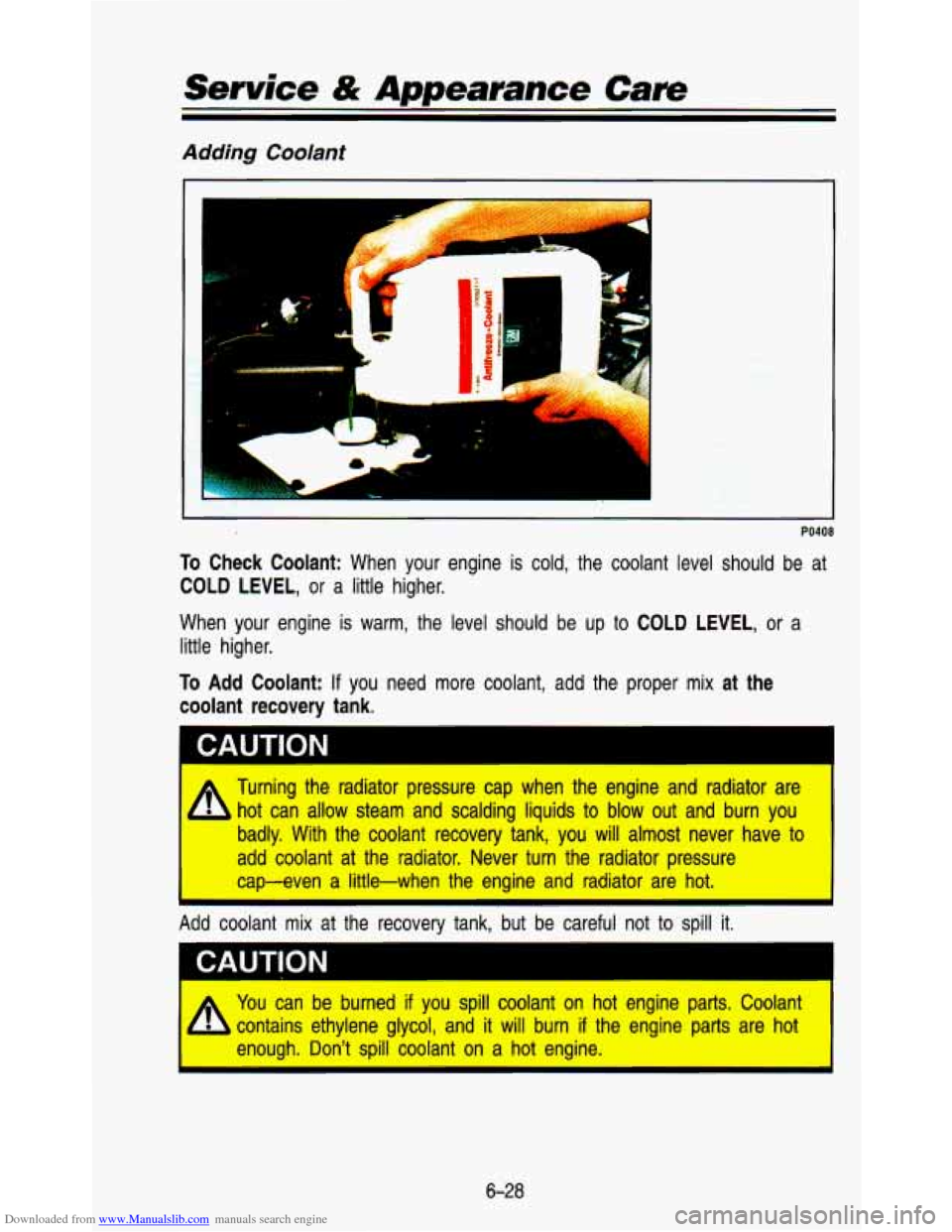
Downloaded from www.Manualslib.com manuals search engine Service & Appearance Care
Adding Coolant
PO408
TO Check Coolant: When your engine is cold, the coolant level should be at
COLD LEVEL, or a little higher.
When your engine is warm, the level should be up
to COLD LEVEL, or a
little higher.
CAUTION
To Add Coolant: If you need more coolant, add the proper mix at the
coolant recovery tank.
Turning the radiator pressure cap when the engine and radiator \
are
hot can allow steam and scalding liquids to blow out and burn you
badly. With the coolant recovery tank, you will almost never h\
ave
to
add coolant at the radiator. Never turn the radiator pressure
cap-even a little-when the engine and radiator are hot.
I
Add coolant mix at the recovery tank, but be careful not to spill it.
CAUTION
i You can be burned if you spill coolant on hot engine parts. Coolant
- contains ethylene glycol, and it will burn if the engine parts are hot
enough. Don't spill coolant on a hot engine.
6-28
Page 266 of 345
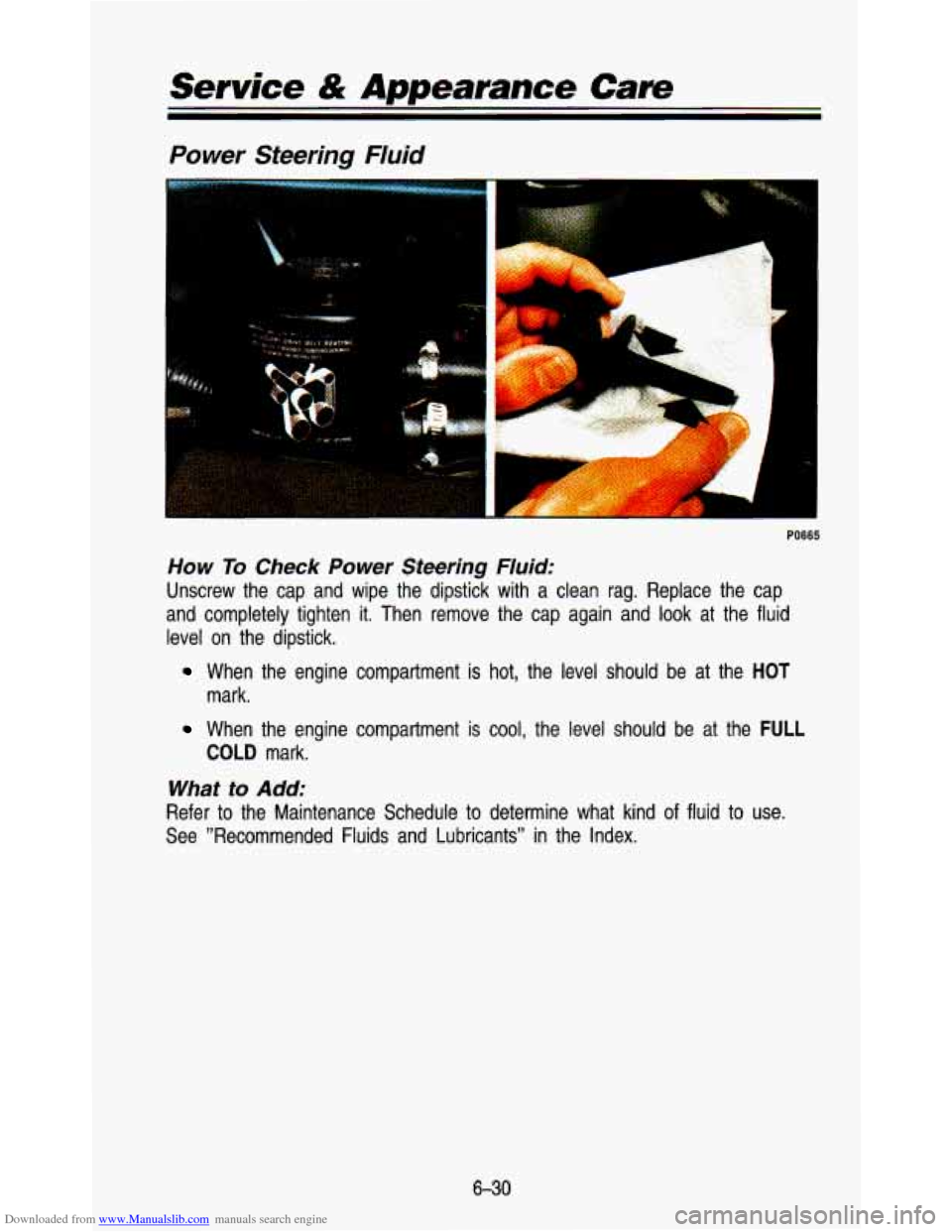
Downloaded from www.Manualslib.com manuals search engine Power Steering Fluid
I
I .
.. ., ...
L
PO665
How To Check Power Steering Fluid:
Unscrew the cap and wipe the dipstick with a clean rag. Repla\
ce the cap
and completely tighten
it. Then remove the cap again and look at the fluid
level on the dipstick.
When the engine compartment is hot, the level should be at th\
e HOT
mark.
When the engine compartment is cool, the level should be at the FULL
COLD mark.
What to Add:
Refer to the Maintenance Schedule to determine what kind of fluid to use.
See ”Recommended Fluids and Lubricants” in the Index.
6-30
Page 269 of 345
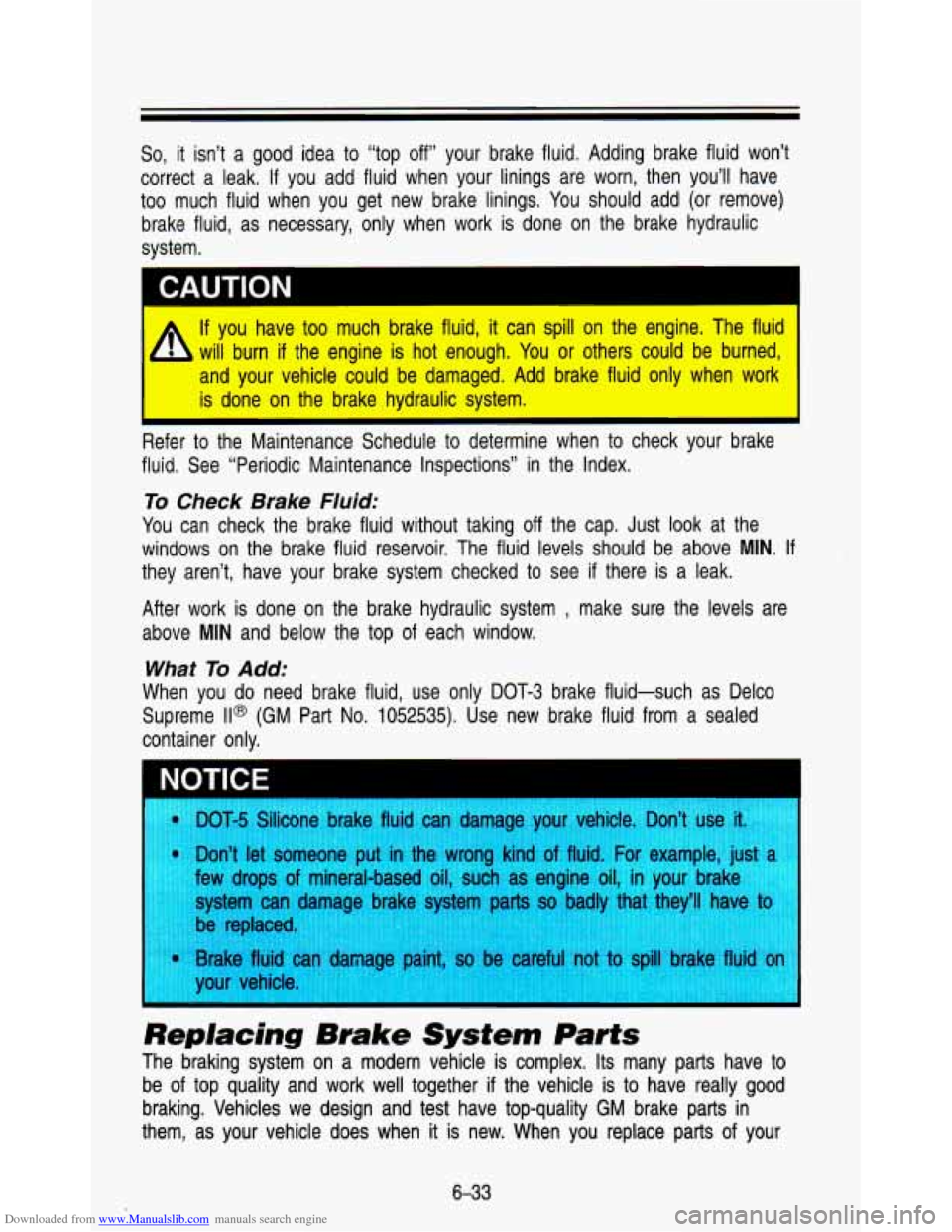
Downloaded from www.Manualslib.com manuals search engine So, it isn’t a good idea to “top off’ your brake fluid. Adding brake fluid won’t
correct a leak.
If you add fluid when your linings are worn, then you’ll have \
too much fluid when you get new brake linings. You should add (or remove)
brake fluid, as necessary, only when work is done on the brake hydraulic
system.
If you have too much brake fluid, it can spill on the engine. The fluid I
will burn if the engine is hot enough. You or others could be burned,
and your vehicle could be damaged. Add brake fluid only when work
is done on the brake hydraulic system.
I
Refer to the Maintenance Schedule to determine when to check your brake
fluid. See “Periodic Maintenance Inspections” in the Index.
To Check Brake Fluid:
You can check the brake fluid without taking off the cap. Just look at the
windows on the brake fluid reservoir. The fluid levels should be above
MIN. If
they aren’t, have your brake system checked to see if there is a leak.
After work is done on the brake hydraulic system
, make sure the levels are
above
MIN and below the top of each window.
What To Add:
When you do need brake fluid, use only DOT-3 brake fluid-such \
as Delco
Supreme
ll@ (GM Part No. 1052535), Use new brake fluid from a sealed
container only.
brake
fLlu lamagn lehicle
Replacing
Brake System Parts
The braking system on a modern vehicle is complex. Its many parts have to
be
of top quality and work well together if the vehicle is to have really good
braking. Vehicles we design and test have top-quality
GM brake parts in
them, as your vehicle does when
it is new. When you replace parts of your
6-33
Page 270 of 345
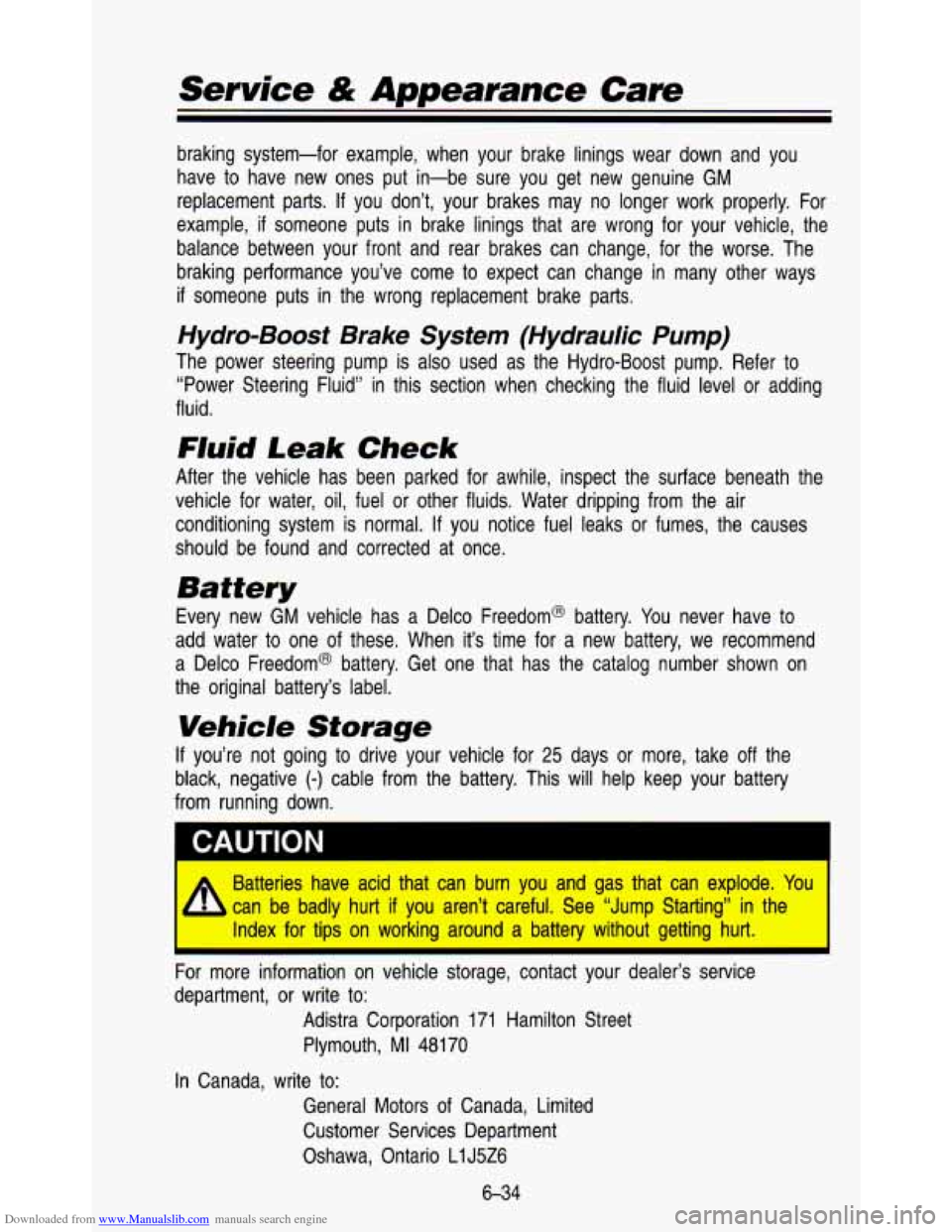
Downloaded from www.Manualslib.com manuals search engine Service & Appearance Care
braking system-for example, when your brake linings wear down and you
have
to have new ones put in-be sure you get new genuine GM
replacement parts.
If you don’t, your brakes may no longer work properly. For
example,
if someone puts in brake linings that are wrong for your vehicle, the
balance between your front and rear brakes can change, for the\
worse. The
braking performance you’ve come to expect can change in many\
other ways
if someone puts in the wrong replacement brake parts.
Hydro-Boost Brake System (Hydraulic Pump)
The power steering pump is also used as the Hydro-Boost pump. \
Refer to
“Power Steering Fluid” in this section when. checking the fluid level or adding
fluid.
Fluid Leak Check
After the vehicle has been parked for awhile, inspect the surf\
ace beneath the
vehicle for water, oil, fuel or other fluids. Water dripping f\
rom the air
conditioning system is normal. If you notice fuel leaks or fumes, the causes
should be found and corrected at once.
Battery
Every new GM vehicle has
add water
to one of these,
a Delco Freedom@ battery.
the original battery’s label. a Delco Freedom@ battery. You never have
to
When it’s time for a new battery, we recommend
Get one that has the catalog number shown on
Vehicle Storage
If you’re not going to drive your vehicle for 25 days or more, take off the
black, negative
(-) cable from the battery. This will help keep your battery
from running down.
I CAUTION
For more informarlon on vehicle storage, contact your dealer’\
s service
department, or write to:
Adistra Corporation 171 Hamilton Street Plymouth,
MI 48170
General Motors
of Canada, Limited
Customer Services Department
Oshawa, Ontario L1 J5Z6
In
Canada, write
to:
6-34
Page 275 of 345
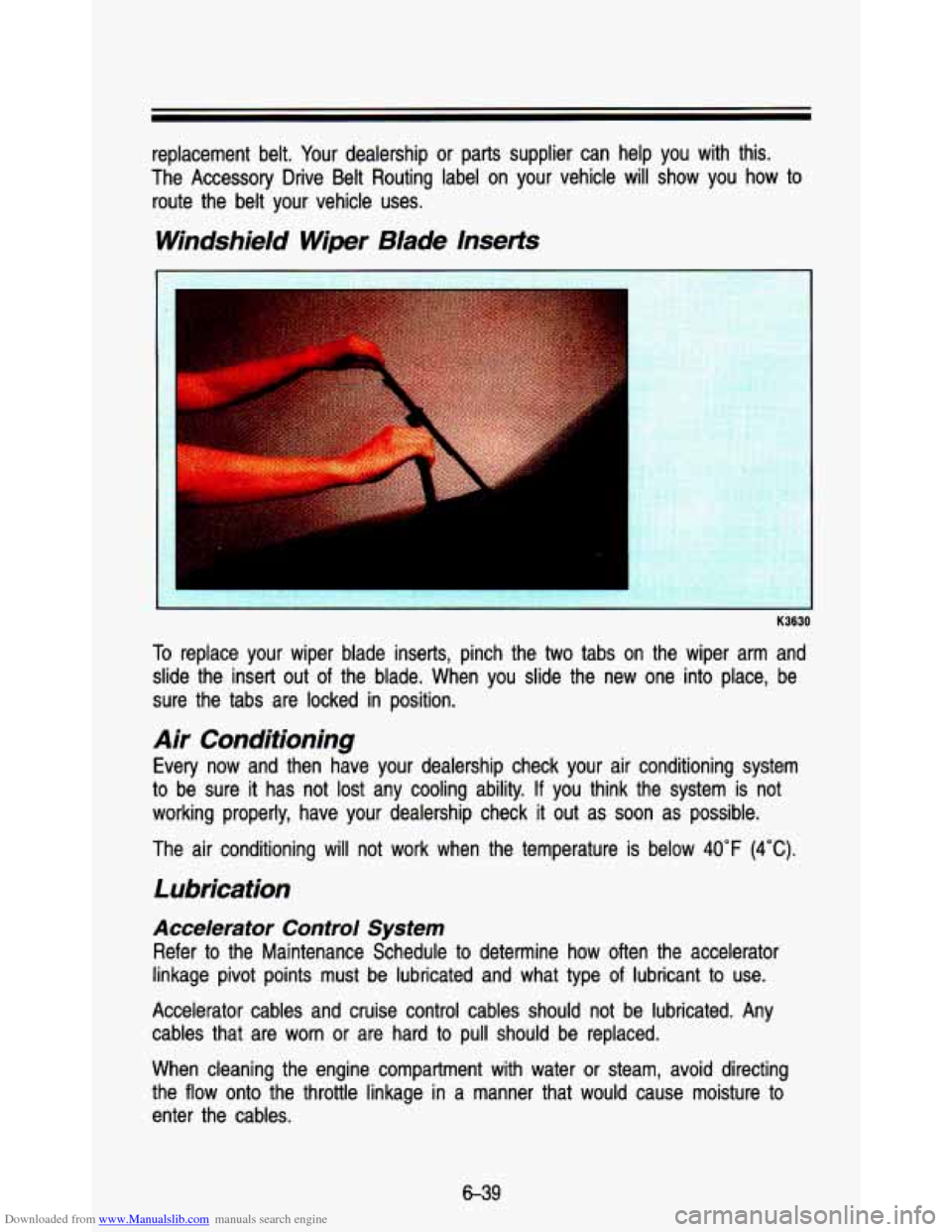
Downloaded from www.Manualslib.com manuals search engine replacement belt. Your dealership or parts supplier can help you with this.
The Accessory Drive Belt Routing label on your vehicle will sh\
ow you how to route the belt your vehicle uses.
Windshield Wiper Blade lnsetts
I
K3630
To replace your wiper blade inserts, pinch the two tabs on the wiper arm and
slide the insert out of the blade. When you slide the new one into place, be
sure the tabs are locked in position.
Air Conditioning
Every now and then have your dealership check your air conditi\
oning system
to be sure it has not lost any cooling ability.
If you think the system is not
working properly, have your dealership check it out as soon as\
possible.
The air conditioning will not work when the temperature is bel\
ow
40°F (4°C).
Lubrication
Accelerator Control System
Refer to the Maintenance Schedule to determine how often the accelerator
linkage pivot points must be lubricated and what type
of lubricant to use.
Accelerator cables and cruise control cables should not be lubr\
icated. Any
cables that are worn
or are hard to pull should be replaced.
When cleaning the engine compartment with water or steam, avoid\
directing
the flow onto the throttle linkage in a manner that would cause moisture to
enter the cables.
6-39
Page 276 of 345
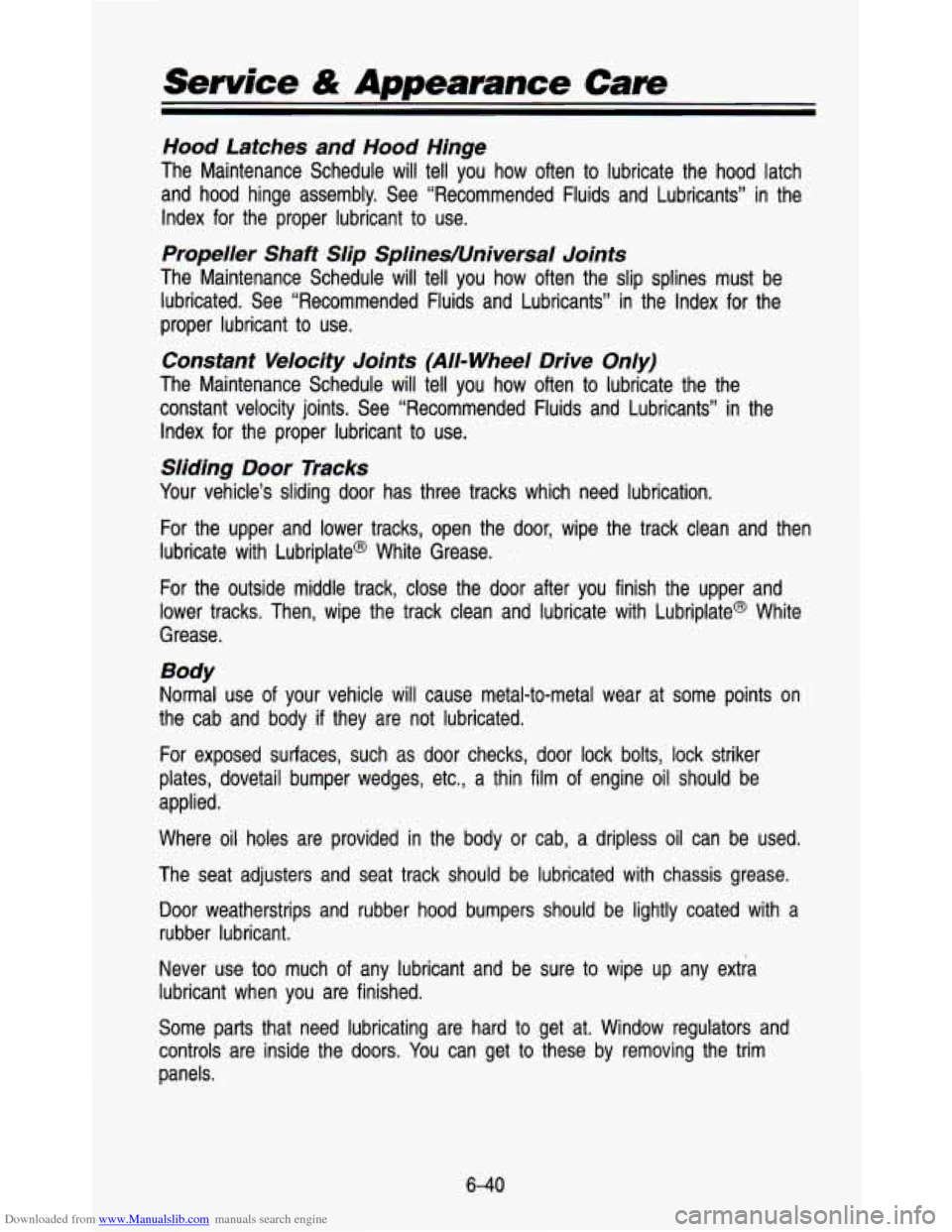
Downloaded from www.Manualslib.com manuals search engine Senrice & Appearance Care
Hood Latches and Hood Hinge
The Maintenance Schedule will tell you how often to lubricate the hood latch
and hood hinge assembly. See “Recommended Fluids and Lubricants”\
in the
Index for the proper lubricant
to use.
Propeller Shaft Slip Splines/Universal Joints
The Maintenance Schedule will tell you how often the slip splines must be
lubricated. See “Recommended Fluids and Lubricants” in the \
Index for the
proper lubricant
to use.
Constant Velocity Joints (All- Wheel Drive Only)
The Maintenance Schedule will tell you how often to lubricate the the
constant velocity joints. See “Recommended Fluids and Lubrican\
ts” in the
Index for the proper lubricant
to use.
Sliding Door Tracks
Your vehicle’s sliding door has three tracks which need lubricatio\
n.
For the upper and lower tracks, open the door, wipe the track\
clean and then
lubricate with Lubriplate@ White Grease.
For the outside middle track, close the door after you finish \
the upper and
lower tracks. Then, wipe the track clean and lubricate with Lu\
briplateB White
Grease.
Body
Normal use of your vehicle will cause metal-to-metal wear at some points \
on
the cab and body
if they are not lubricated.
tor exposed surfaces, such as door checks, door lock bolts, lock s\
triker
plates, dovetail bumper wedges, etc., a thin film
of engine oil should be
applied.
Where oil holes are provided in the body or cab, a dripless \
oil can be used.
The seat adjusters and seat track should be lubricated with chassis grease.
Door weatherstrips and rubber hood bumpers should be lightly coated with
a
rubber lubricant.
Never use
too much of any lubricant and be sure to wipe up any extra
lubricant when you are finished.
Some parts that need lubricating are hard
to get at. Window regulators and
controls are inside the doors. You can get to these by removing the trim
panels.
6-40
Page 281 of 345
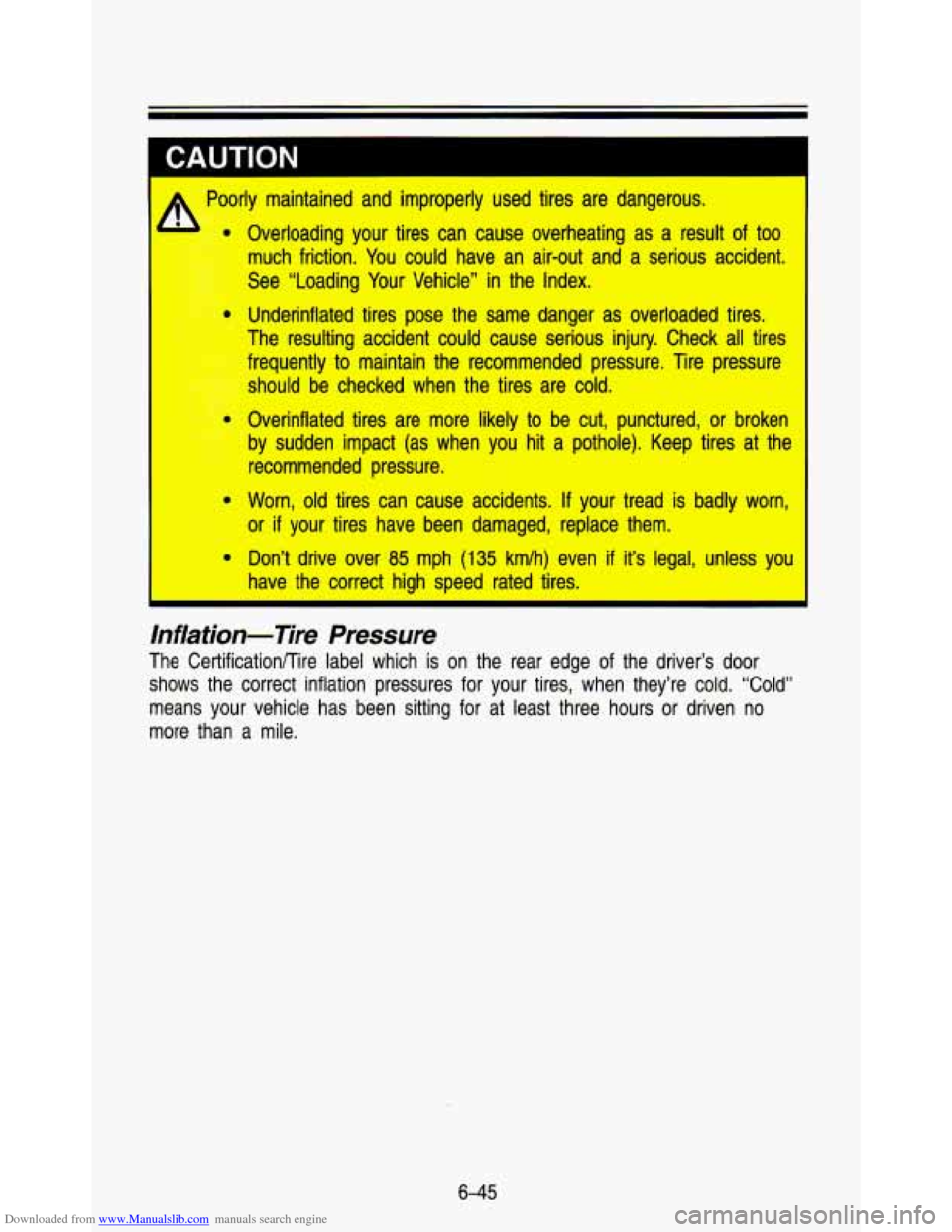
Downloaded from www.Manualslib.com manuals search engine A Poorly maintained and improperly used tires are dangerous. Overloading your tires can cause overheating as a result of too
much friction.
You could have an air-out and a serious accident.
See “Loading Your Vehicle” in the Index.
Underinflated tires pose the same danger as overloaded tires.
The resulting accident could cause serious injury. Check all ti\
res
frequently to maintain the recommended pressure. Tire pressure
should be checked when the tires are cold.
Overinflated tires are more likely to be cut, punctured, or broken
by sudden impact (as when you hit a pothole). Keep tires at\
the recommended pressure.
Worn, old tires can cause accidents.
If your tread is badly worn,
or
if your tires have been damaged, replace them.
Don’t drive over
85 mph (1 35 km/h) even if it’s legal, unless you
have the correct high speed rated tires.
Inflation-Tire Pressure
The Certification/Tire label which is on the rear edge of the driver’s door
shows the correct inflation pressures for your tires, when they’re cold\
. “Cold”
means your vehicle has been sitting for at least three hours \
or driven no
more than a mile.
6-45
Page 282 of 345
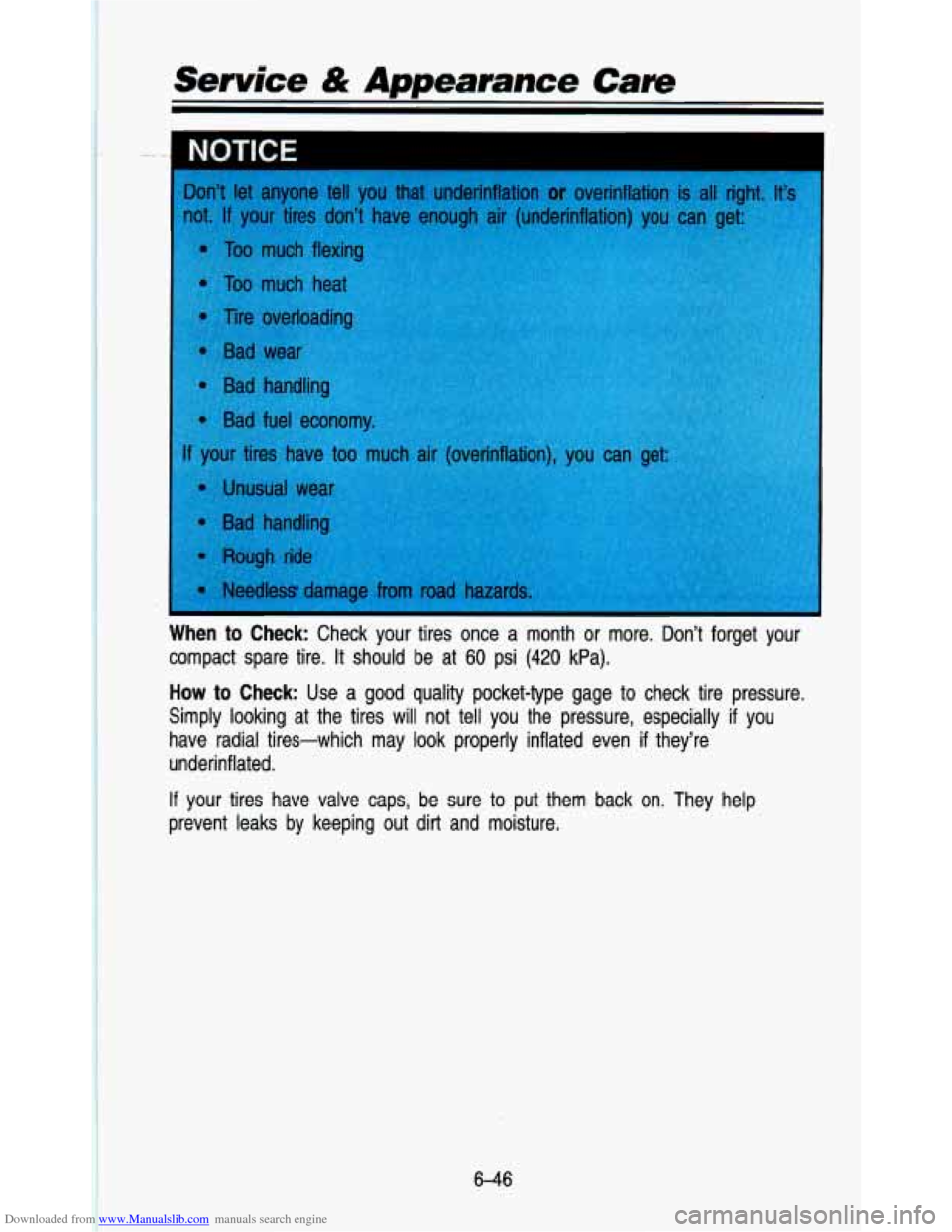
Downloaded from www.Manualslib.com manuals search engine Senrice & Appearance Care
on’t let anyone tell you that underinflation or overinflation is all right. It’s
When to Check: Check your tires once a month or more. Don’t forget your
compact spare tire.
It should be at 60 psi (420 kPa).
How to Check: Use a good quality pocket-type gage to check tire pressure.
Simply looking at the tires will not tell you the pressure, e\
specially
if you
have radial tires-which may look properly inflated even
if they’re
underinflated.
If your tires have valve caps, be sure to put them back on. They help
prevent leaks by keeping out dirt and moisture.
6-46